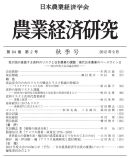All issues

Volume 84 (2012)
- Issue 4 Pages 203-
- Issue 3 Pages 157-
- Issue 2 Pages 57-
- Issue 1 Pages 1-
Volume 84, Issue 3
Displaying 1-2 of 2 articles from this issue
- |<
- <
- 1
- >
- >|
full-paper
-
The Case of Skim MilkSatoshi HOKAZONO, Koushi MAEDA2012 Volume 84 Issue 3 Pages 157-171
Published: December 25, 2012
Released on J-STAGE: March 31, 2015
JOURNAL FREE ACCESSThe purpose of this paper is to quantitatively analyze trade effects of ensuring export discipline through parallelism. A newly developed spatial equilibrium model includes export subsidies, exporting state trading enterprises (exporting STEs) and imperfect competition. The model is applied to international skim milk trade. The main results of the policy simulations are as follows. Firstly, skim milk trade has been distorted by export subsidies in the EU and exporting STEs in New Zealand and Canada. Secondly, the distortion might be greatly corrected by ensuring export discipline through parallelism. Thirdly, supported by the United States and Japan, which receive its benefits, the EU will keep advocating parallelism in the ongoing WTO agricultural negotiations.View full abstractDownload PDF (366K) -
Tsaiyu CHANG2012 Volume 84 Issue 3 Pages 172-184
Published: December 25, 2012
Released on J-STAGE: March 31, 2015
JOURNAL FREE ACCESSPast studies have pointed out that small farmers tend to continue farming for the purpose of keeping the proprietary rights to the farmland as assets, which is one of the reasons holding back the improvement of the agricultural structure in Taiwan. This paper examined farmland regulation in Taiwan and calculated the total revenue by farmland conversion in Taiwan. Then, the determinants of farmland price are estimated by the hedonic approach. From these analyses, it was shown that the total revenue of farmland conversion from 1992 to 2003 in Taiwan was 0.5-1.5 times the revenue from crop production. Furthermore, the analysis of the farmland price in the two years after May 2008 by hedonic approach shows that not only the quality of farmland, which raises the agricultural profit, but also such factors related to farmland conversion as the degree of population density and zoning regulations influence the farmland price.View full abstractDownload PDF (486K)
- |<
- <
- 1
- >
- >|